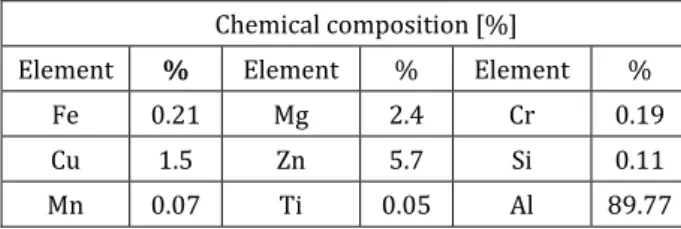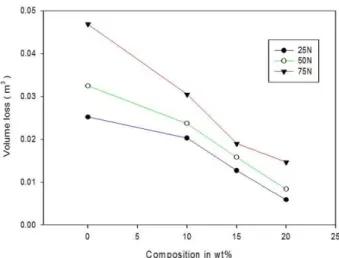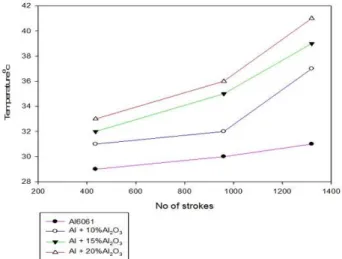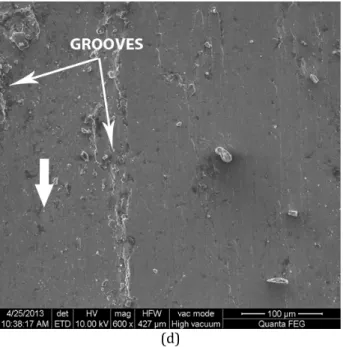Tribology
in
Industry
www.tribology.fink.rsReciprocating
Wear
Behaviour
of
7075Al/SiC
and
6061Al/Al
2
O
3
Composites:
A
study
of
Effect
of
Reinforcement,
Stroke
and
Load
J. Lakshmipathy
a, B. Kulendran
baArunai Engineering College, Tiruvannamalai, Tamilnadu, India,
bInstitute of Road and Transport Technology, Erode, Tamilnadu, India.
Keywords:
Sliding wear Casting
Metal matrix‐ composites Wear testing
Electron microscopy
A B S T R A C T
The wear behaviour comparison of Al/SiC and Al/Al2O3 composites prepared by
stir casting technique is investigated to find out the effects of weight
percentage of SiC/Al2O3, load and the number of strokes on a reciprocating
wear testing machine. The MMC pins are prepared with different weight
percentage of SiC and Al2O3 (10, 15 and 20 %). The tests are carried out with
different load conditions (25, 50 and 75 N) and different number of strokes
(420,780 and 1605 strokes). Wear surfaces of tested samples are examined in
Scanning Electron Microscope (SEM). Hardness test and impact test are also
carried out on the MMC samples. The experimental results shows that hardness
of composites increases with increase in SiC and Al2O3 particle and the impact
strength decreases with increase in SiC and Al2O3 content. The volume loss of
MMC specimens are less than that of the matrix alloy. The temperature rise
near the contact surface of the MMC specimens increases with increase in wt%
of SiC and Al2O3, load and number of strokes. The coefficient of friction
decreases with increase in the number of strokes. The WVAS (Wireless
Vibration Acquisition System) interfaced with MAT Lab software is used to
record the amplitudes during the test.
© Published by Faculty of Engineering
Corresponding author:
Jayakumar Lakshmipathy Arunai Engineering College, Tiruvannamalai,
Tamilnadu, India.
E‐mail: jkpathy@gmail.com
1. INTRODUCTION
Metal matrix composites are mainly used to provide advantageous over monolithic metals such as steel and aluminium. MMC’s have several advantages such as higher elastic properties, higher service temperature, insensitivity to moisture, higher electric and thermal conductivities and better wear, fatigue and flaw resistances. Metal matrix composites are widely used in automotive engines because of their high
strength and low weight. A variety of metals and their alloys can be used as matrix materials, but aluminium alloys are widely used because of their low density and excellent strength, toughness and resistance to corrosion. Applications of aluminum matrix composites are space shuttle, military, transportation. Particle reinforced MMC’s have become very important because they are inexpensive and they have relatively isotropic properties compared to fiber reinforced composites.
Generally AMC’s are employed in moving or sliding applications, therefore investigation of the tribological properties of these materials is essential to reflect the behaviour of these materials in real situations.
Many investigators demonstrated the effect of reinforcement size, volume fraction, applied load, sliding distance and temperature on dry sliding wear behaviour of aluminium matrix composites. The reinforcing particles benefit the wear behaviour delaying the transition to higher normal loads [ ].Significant improvement in wear resistance achieved by the addition of SiC particles [ ]. The crack density increases with increase in the quantity of reinforcement. Also they reported that the specific wear rate increases with decrease of reinforcement size for a certain volume percentage of SiC [ ]. The wear rate and coefficient of friction varies based on the sliding velocity [ ]. Addition of SiC reduces the plastic deformation and increases the wear resistance [ ]. Wear rate of composite decreases with increase of SiC [ ]. The increase of volume fraction of reinforcement increases the wear resistance [ ].
From the literature review, it was understood that the most of the experiments were conducted on pin–on disc machine. To the best of our knowledge, very few researches are carried out by reciprocating wear test method. )n the present work an attempt is made to correlate the dry sliding wear behaviour of cast alloy and the composites by reciprocating test method using reciprocating wear testing machine.
2. EXPERIMENTALSETUPANDPROCEDURE
2.1 Materials
The matrix material selected for the present studies is Al and Al alloy and is procured from Jindal Aluminium limited, Bangalore, in the form of ingots. The chemical
composition of Al T alloy and Al T
is shown in Table and Table . The SiC and
Al O of micron size is selected as
reinforcement material, which is supplied by M/s Snam Abrasives Pvt. Ltd, (osur, TamilNadu, )ndia.
Table1. Composition of Al –T alloy.
Chemical composition [%]
Element % Element % Element %
Fe . Mg . Cr .
Cu . Zn . Si .
Mn . Ti . Al .
Table2. Composition of Al –T alloy.
Chemical composition [%]
Element % Element % Element %
Fe . Mg . Cr .
Cu . Zn . Si .
Mn . Ti . Al .
2.2Processing
The composite specimens are prepared by stir casting method. The photograph of the mould used for casting and the castings are shown in Fig. . From the obtained composites, specimens are prepared for various tests.
a b
Fig.1. Photograph of a Mould and b Castings.
2.3HardnesstestandImpacttest
The hardness of cast alloy and their composites containing %, % and % wt.% of SiC and Al O are found using Brinell hardness tester having a steel ball indenter with a load of N. The impact strength of matrix alloy and their composites are found using )zod and Charphy test.
2.4Weartest
Fig.2. Schematic diagram of experimental setup used
for wear tests.
)nitial weight of the specimen is weighed using electronic balance Model: DX having an accuracy of . mg. The k type thermocouple is attached in the specimen near the contact surface. A vibrometer is fitted on top of the specimen, who is connected to the transmitter and the receiver is connected with the computer. This WVAS integrated with MATLAB software are used to record the time versus amplitude plot during the test. Friction forces are measured from force transducer which is placed under the steel plate. After the test the final weight of the specimen is measured. The mass loss of the specimen is calculated by finding the difference between initial and final weight. The measured values of mass loss for all the specimens tested were converted in to volume loss using measured density of the alloy. The mass loss of the specimen was used to study the effect of SiC addition, load and number of strokes on the wear resistance of the composite materials. The worn surfaces of the samples were examined using SEM.
3. RESULTSANDDISCUSSION
3.1Hardnessstudies
The Brinell hardness of cast Al T and Al T matrix alloy and its composites containing %, % and % SiC and Al O are found using a steel ball indenter at an applied load of N. The hardness results of
Al/SiC and Al/Al O composites are
shown in Figs. and . )t is observed that the hardness of the Al/SiC composites is higher than that of Al/Al O composites.
Fig.3. Brinell hardness of Al ‐SiC composite with
different composition of SiC.
Fig. 4. Brinell hardness of Al ‐Al O composite
with different composition of Al O .
3.2Impactstrength
The impact strength of Al and alloy
and its composites containing %, % and % SiC and Al O are found using charphy and )zod test. The Figs. and shows that the impact strength decreases with increase of wt% of SiC and Al O .
Fig.5. )mpact strength of Al ‐SiC composite with
Fig. 6. )mpact strength of Al ‐Al O composite
with different composition of Al O .
When the hardness increases the brittle property of the material increases this reduces the impact strength of the composites in both cases. These results are in agreement with those reported by [ , ].
3.3Wearbehaviour
The Figs. ‐ shows that the volume loss of composites for different load at , and strokes. )t can be observed that the volume loss decreases with increase of weight percentage of SiC. The volume loss of matrix alloy is more than that of composites. )ncreasing the weight percentage of reinforcement improves the hardness of the composites which improves the wear resistance of the composites [ ]. )t can be noted that when the number of strokes increases the volume loss increases. Also it can be seen that when the load increases the volume loss increases [ ]. The same tendency can be observed for Al alloy and its Composites Figs. ‐ . But the volume loss is more in the case of Al alloy and its
composites compare to Al and its
composites. Composite with % SiC exhibits better wear resistance compared to the matrix alloy and other compositions in both cases. The previous studies carried out by [ , ] showed that wear resistance of the alloy is improved by the addition of SiC particle. The wear rate increases with increase in sliding speed and applied load [ ].
Fig.7.Volume loss of Al alloy and its composites
at strokes.
Fig.8.Volume loss of Al alloy and its composites
at strokes.
Fig.9.Volume loss of Al alloy and its composites
Fig. 10. Volume loss of Al alloy and its
composites at strokes.
Fig. 11. Volume loss of Al alloy and its
composites at strokes.
Fig. 12. Volume loss of Al alloy and its
composites at strokes.
3.4 Increase in contact temperature as a functionofnumberofstrokes
The increase in contact surface temperature near the contact surface is recorded during the
test. From the Figs. ‐ it is noted that when the number of strokes increases the contact temperature increases. Compared to matrix alloy the temperature rise is more in composites.
Fig.13. )ncrease in contact temperature of Al
alloy and its composites at N.
Also it can be observed that the temperature near the contact surfaces increases with increase in applied load.
Fig. 14. )ncrease in contact temperature of Al
alloy and its composites at N.
Fig. 15. )ncrease in contact temperature of Al
alloy and its composites at N.
Fig. 16. )ncrease in contact temperature of Al
alloy and its composites at N.
Fig.17.)ncrease in contact temperature of Al
alloy and its composites at N
From the Fig ‐ it can be observed that the temperature rise near the contact surface in the case of Al and its composites is less than that of the Al and its composites.
Fig. 18. )ncrease in contact temperature of Al
alloy and its composites at N.
3.5 Coefficient of friction as a function of numberofstrokes
The Figs. and shows the effect in number of strokes at the load of N on the coefficient of friction. )t can be understood that the coefficient of friction decreases with increase in the number of strokes also increases with increase in SiC and Al O content. The amount of reinforcement particles present in the composites attributed to higher coefficient of friction but increase in number of strokes reduces the coefficient of friction. When the number of strokes increases, the sliding distance increases with increase in contact temperature, leads to the softening of the surface and thus more slipping action occurs between the contact surfaces there by reduces the coefficient of friction [ ‐ ]. The coefficient of friction of composites is higher than that of the matrix alloy.
Fig.19.Coefficeient of friction of Al alloy and its
Fig.20.Coefficeient of friction of Al alloy and its
composites at N.
3.6 WVAS (Wireless Vibration Acquisition System)
WVAS is used to observe the asperities contacts in between the two contacting surfaces. WVAS interfaced with MATLAB software are used to record the amplitudes during the test. The amplitude plots are obtained for maximum
strokes and the maximum load N for
different composition of SiC. From the Figs. a‐c it can be noted that based on the amount of reinforcement particle, the number of peak amplitude observed.
a
b
c
Fig. 21. Amplitude Vs Time graph at max.load and
max.storkes a Al with %SiC; b Al with %SiC and c Al with %SiC.
)t is due to the more number of reinforcement particles comes in contact between the two contacting surfaces. )t can be clearly observed from the Figs. a‐c for the matrix alloy with % SiC has less number of peak amplitudes compared to Al+ %SiC and Al+ % SiC. Due to the more number of strokes and the maximum load the more wear debris generated in between the mating surfaces which is evidently shown by the more number of peak amplitudes in
composites with %SiC. The similar
observation is recorded for Al composites. The previous work carried out by [ ] presented the LVDT records with sliding distance.
3.7Wornsurfacesofalloyandcomposites
The worn surfaces of alloy and composites with %, and % SiC and Al O at load of N with strokes observed using SEM. Figure a shows the SEM graph of Al ‐ %Al O . )t indicates the more fragmented particles and damaged regions. Figure b shows the SEM graph of worn surface of Al ‐ % SiC. )t shows narrow grooves and minimum removal of material in the wavy form. Figure c shows the
SEM micrograph of Al ‐ %Al O . )t indicates
content [ ‐ ]. As a result, the volume loss of the composite is noted to be significantly lower than that of the alloy.
a
b
c
d
Fig. 22. SEM micrograph of the worn surfaces: a
Al ‐ %Al O ; b Al ‐ %SiC; c Al ‐ %Al O ; d Al ‐ % SiC.
4.CONCLUSIONS
Tribological behaviour of Al T , Al T
alloy and its composites containing %, % and % wt % SiC and Al O has been experimentally analysed using reciprocating wear test method, leading to the following conclusions.
(ardness of composites increases with increasing of SiC and Al O content. Al ‐ % SiC exhibits maximum hardness of B(N
where as B(N for Al ‐ %Al O . )mpact
strength of composite is decreasing with increase in wt.% of SiC and Al O reinforcement.
Composite with Al ‐ %SiC and Al ‐
%Al O reinforcement shows better wear resistance compared to its matrix alloy and other compositions. But the wear resistance is more for Al ‐SiC composites compared to
Al ‐ Al O .
)ncrease in number of strokes, the volume loss increases. Also increase in number of strokes and wt.% of reinforcement, the contact temperature increases. The temperature rise in
Al ‐Al O composites is minimum when
compared to the Al ‐SiC composites.
composite is higher than that of the matrix alloy in both composites. But the magnitude of the coefficient of friction is minimum for Al ‐ Al O composites compare to the Al ‐SiC composites for the identical test conditions.
The amplitude versus time graph was recorded using WVAS. More number of peak amplitude observed for Al‐ % reinforcement composite. The formation of wear grooves and fragmented particles observed at maximum number of strokes and maximum load. Composite with % SiC shows less wear regime compared to alloy and other compositions.
REFERENCES
[ ] T. Gomez‐del Rio, A. Rico, M.A. Garrido, P. Poza, J. Rodriguez: Temperature and velocity
transitions in dry sliding wear of Al‐Li/SiC
composites, Wear, Vol. , No. ‐ , pp. ‐ ,
.
[ ] Adel Mahamood (assan, Abdalla Alrashdan, Mohammed T. (ayajneh, Ahmad Turki Mayyas:
Wear behavior of Al‐Mg‐Cu‐based
compositescontaining SiC particles, Tribol. )nt,
Vol. , No. , pp. ‐ , .
[ ] S.K. Ghosh, Partha Saha: Crack and wear
behaviour of SiC particulate reinforced
aluminium based metal matrix composite
fabricated by direct metal laser sintering process,
Mater. Des., Vol. , No. , pp. ‐ , . [ ] N. Jha, Anshul Badkul, D.P. Mondal, S. Das, M.
Singh: Sliding wear behaviour of aluminium syntactic foam: A comparison with Al‐10 wt% SiC
composites, Tribol. )nt , Vol. , No. , pp. ‐
, .
[ ] P. Rodrigo, M. Campo, B. Torres, M.D. Escalera, E. Otero, J. Rams: Microstructure and wear
resistance of Al‐SiC composites coatings on ZE41
magnesium alloy, Appl. Surf. Sci, Vol. , No. ,
pp. ‐ , .
[ ] Y. Sahin, V. Kilicli: Abrasive wear behaviour of
SiCp/Al alloy composite in comparison with
ausferritic ductile iron, Wear, Vol. , No. ‐ ,
pp. ‐ , .
[ ] G.B. Veereshkumar, C.S.P. Rao, M. Selvaraj:
Studies on mechanical and Dry sliding wear of
Al6061‐SiC composites, Composites: part B, Vol.
, No. , pp. ‐ , .
[ ] Bekir Sadik Unlu: Investigation of tribological and
mechanical properties Al2O3‐SiC reinforced Al
composites manufactured by casting or P/M
method, Mater. Des., Vol. , No. , pp. ‐ ,
.
[ ] Tamer Ozben, Erol kilickap,Orhan Cakir:
Investigation of mechanical and machinability
properties of SiC particle reinforced Al‐MMC, J.
Mater. Process. Technol., Vol. , No. ‐ , pp. ‐ , .
[ ] Ranjit Bauri, M.K. Surappa: Sliding wear
behaviour of Al‐Li‐SiCp composites, Wear, Vol.
, No. ‐ , pp. ‐ , .
[ ] S. Mitrović, M. Babić, B. Stojanović, N. Miloradović, M. Pantić, D. Džunić: Wear
Properties of A356/10SiC/1Gr Hybrid Composites
in Lubricated Sliding Conditions, Tribology in
)ndustry, Vol. , No. pp. ‐ , . [ ] S. Mitrović , M. Babić , B. Stojanović , N.
Miloradović , M. Pantić, D. Džunić: Tribological Potential of Hybrid Composites Based on Zinc and
Aluminium Alloys Reinforced with SiC and
Graphite Particles, Tribology in )ndustry, Vol. ,
No. , pp. ‐ , .
[ ] S. Kumar, V. Balasubramanian: Effect of
reinforcement size and volume fraction on the
abrasive wear behaviour of AA7075 Al/SiCp P/M
composites‐A statistical analysis, Tribol. )nt, Vol.
, No. ‐ , pp. ‐ , .
[ ] Adem Onat: Mechnaical and dry sliding wear
properties of silicon carbide particulate
reinforced aluminium‐copper alloy matrix
composites produced by direct squeeze casting
method, J. Alloys and Comp, Vol. , No. , pp.
‐ , .
[ ] R.N. Rao, S. Das: Effect of matrix alloy and
influence of SiC particle on the sliding wear
characteristics of aluminium alloy composites,
Mater. Des, Vol. , No. , pp. ‐ , . [ ] R.N. Rao, S. Das, D.P. Mondal, G. Dixit: Dry sliding
wear behavior of cast high strength aluminium
alloy (Al‐Zn‐Mg) and hard particle composites,
Wear, Vol. , No. ‐ , pp. ‐ , . [ ] S.M.R. Mousavi, Abarghouie, S.M. Seyed Reihani:
Investigation of friction and wear behaviors of
2024 Al/SiCp composite at elevated temperatures, J. Alloys and Comp., Vol. , No. , pp. ‐ ,
.
[ ] J.O. Agunsoye, E.F. Ochulor, S.). Talabi, S. Olatunji: Effect of Manganese Additions and Wear
Parameter on the Tribological Behaviour of
NFGrey (8) Cast Iron, Tribology in )ndustry, Vol.
, No. , pp. ‐ , .
[ ] Sudashan, M.K.surappa: Dry sliding wear of fly
ash particle reinforced A356 Al composites, Wear,
[ ] S. Das, D.P. Mondal, S. Sawla, N. Ramakrishnan:
Synergic effect of reinforcement and heat
treatment on the two body abrasive wear of an
Al‐Si alloy under varying loads and abrasive sizes,
Wear, Vol. , No. ‐ , pp. ‐ , .
[ ] Rupa Dasgupta: Sliding wear resistance of Al‐
alloy particulate composites: An assessment on
its efficacy, Tribol. )nt., Vol. , No. ‐ , pp. ‐ , .
[ ] S.A. Alidokht, A. Abdollah‐Zadeh, S. Soleymani, (. Assadi: Microstructure and tribological
performance of an aluminium alloy based hybrid
composite produced by friction stir processing,






